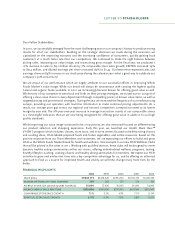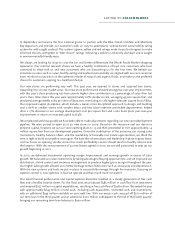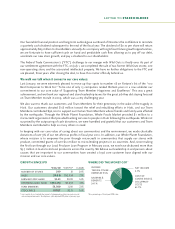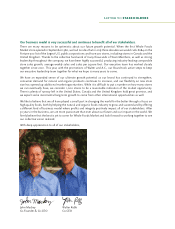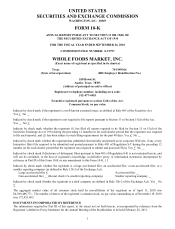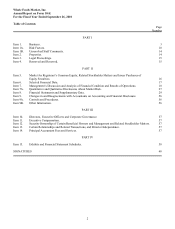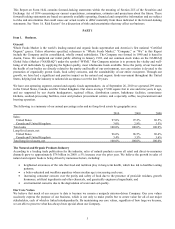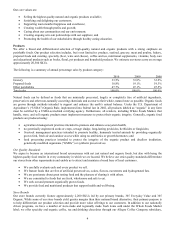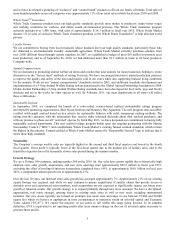Whole Foods 2010 Annual Report Download - page 13
Download and view the complete annual report
Please find page 13 of the 2010 Whole Foods annual report below. You can navigate through the pages in the report by either clicking on the pages listed below, or by using the keyword search tool below to find specific information within the annual report. 7
million per store. In comparison, our stores opened during fiscal year 2009, including six relocations, averaged 53,500
square feet in size, and the average new store investment was approximately $16.9 million, or $316 per square foot; new
store inventory averaged $1.1 million, and pre-opening and relocation expenses averaged approximately $3.0 million.
Purchasing and Distribution
The majority of our purchasing, particularly in dry grocery, occurs at the regional and national levels, enabling us to
negotiate better volume discounts with major vendors and distributors while allowing our store buyers to focus on local
products and the unique product mix necessary to keep the neighborhood market feel in our stores. We are increasingly
focusing more of our purchasing on producer-direct and manufacturer-direct programs, and we remain committed to buying
from local producers that meet our high quality standards.
We own two produce procurement centers which facilitate the procurement and distribution of the majority of the produce
we sell. We also operate four seafood-processing and distribution facilities, a specialty coffee and tea procurement and
brewing operation, and 10 regional distribution centers that focus primarily on perishables distribution to our stores across
the U.S., Canada and the United Kingdom. In addition, we have five regional commissary kitchens and six bakehouse
facilities, all of which distribute products to our stores. Other products are typically procured through a combination of
specialty wholesalers and direct distributors.
United Natural Foods, Inc. (“UNFI”) is our single largest third-party supplier, accounting for approximately 27% of our total
purchases in fiscal year 2010. In June 2010, we extended our long-term relationship with UNFI as our primary supplier of
dry grocery and frozen food products through 2020. A separate agreement signed in July 2010 made UNFI our primary non-
perishables distributor in an additional two regions, beginning in fiscal year 2011, allowing us to focus our internal
distribution efforts in our regions around key perishable departments.
Store Operations
We strive to promote a strong Company culture featuring a team approach to store operations that we believe is distinctly
more empowering of team members than that of the traditional supermarket. Our domestic Whole Foods Market stores each
employ between 45 and 650 team members who comprise up to 13 self-managed teams per store, each led by a team leader.
Each team within a store is responsible for a different product offering or aspect of store operations such as prepared foods,
grocery, or customer service, among others. We also promote a decentralized approach to store operations in which many
decisions are made by teams at the individual store level. In this structure, an effective store team leader is critical to the
success of the store. The store team leader works closely with one or more assistant store team leaders, as well as with all of
the department team leaders, to operate the store as efficiently and profitably as possible.
Team members are involved at all levels of our business. We strive to create a Company-wide consciousness of “shared fate”
by uniting the interests of team members as closely as possible with those of our shareholders. One way we reinforce this
concept is through our Gainsharing program. Under Gainsharing, as part of our annual planning process, each store and team
receives a labor budget expressed as a percentage of sales, with leverage built into the budgets on an overall Company basis.
When teams come in under budget due either to higher sales or lower labor costs, a portion of the surplus is divided among
the team members to boost their hourly pay and a portion is set aside in a savings pool. When teams are over budget (or in a
labor deficit position), no Gainsharing money is paid out. Instead, the overage is taken out of the team’s savings pool or, in
the absence of savings, paid back using future surpluses. Rewarding our team members for increases in labor productivity,
something they can control, gives them a direct stake in the success of our business. We also encourage stock ownership
among team members through our broad-based team member stock option plan, stock purchase plan and 401(k) plan.
Team Members
As of September 26, 2010, we had approximately 58,300 team members, including approximately 45,300 full-time, 10,700
part-time and 2,300 temporary team members. Full-time team members accounted for approximately 81% of all permanent
positions at the end of fiscal year 2010 compared to 85% at the end of fiscal year 2009. Voluntary turnover of full-time team
members improved to 9% in fiscal year 2010 from 12% in fiscal year 2009, which we believe is very low for the food
retailing industry and allows us to better serve our customers. All of our team members are non-union, and we consider our
team member relations to be very good.
We believe in empowering our team members to make Whole Foods Market not only a great place to shop but a great place
to build a career. Our salary and benefits programs reflect our philosophy of egalitarianism. To ensure they are perceived as
fundamentally fair to all stakeholders, our books are open to our team members, including our annual individual
compensation report. We also have a salary cap that limits the total cash compensation paid to any team member in a
calendar year to 19 times the average annual wage of all team members. In addition, our co-founder and co-chief executive
officer, John Mackey, has voluntarily set his annual salary at $1 and receives no cash bonuses or stock option awards.


